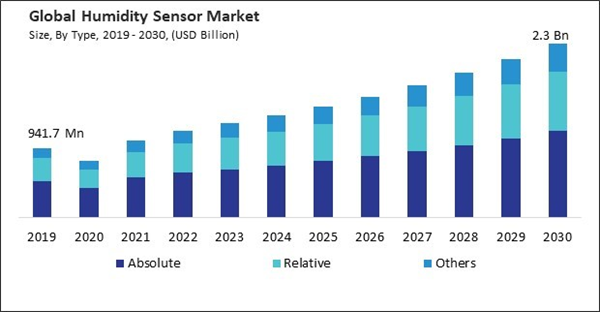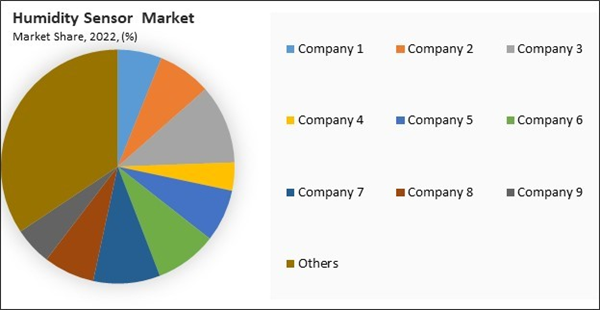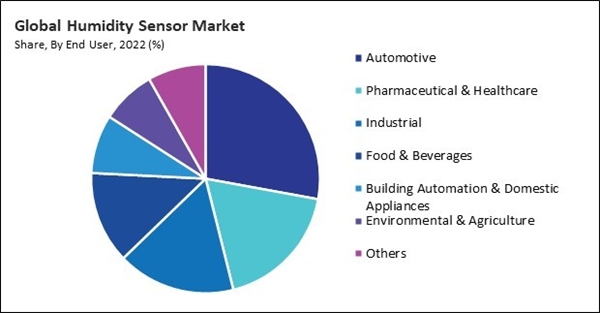The Global Humidity Sensor Market size is expected to reach $2.3 billion by 2030, rising at a market growth of 9.2% CAGR during the forecast period. In the year 2022, the market attained a volume of 3504.1 thousand units, experiencing a growth of 9.0% (2019-2022).
In industrial settings, humidity can contribute to equipment corrosion. Humidity sensors monitor and control moisture levels, safeguarding machinery, electronic components, and sensitive equipment from corrosion-related damage. Humidity control is crucial in optimizing various production processes. Consequently, the industrial segment will generate a 17.1% revenue share of the market by 2030. Also, Russia would utilize 56.0 thousand units of humidity sensor at industrial by 2030. Industries such as textiles, printing, and paper manufacturing rely on humidity sensors to maintain ideal moisture levels, preventing issues like paper curling, static electricity, and dimensional variations in materials.
Humidity sensors are used in smart home devices to monitor and control indoor climate conditions. This is especially important for smart thermostats and climate control systems, as they can adjust temperature and humidity levels for comfort and energy efficiency. Wearable devices like fitness trackers and smartwatches often incorporate humidity sensors for more comprehensive health monitoring. Hence, these factors will boost the demand for humidity sensors in the future.
Additionally, Humidity sensors are integral components of building automation systems within smart buildings. These sensors help regulate climate control systems, ensuring optimal indoor conditions for occupants. This is crucial for both comfort and energy efficiency. In smart buildings, humidity sensors contribute to energy management strategies. Thus, these factors will assist in the growth of the market.
However, in price-sensitive markets, cost is a critical factor influencing purchasing decisions. If the manufacturing costs of humidity sensors are high, the final product's price may be elevated, making it less competitive compared to lower-cost alternatives. This, in turn, can limit the adoption of humidity sensors in certain applications and industries. Hence, these factors can assist in the growth of the market.
The leading players in the market are competing with diverse innovative offerings to remain competitive in the market. The above illustration shows the percentage of revenue shared by some of the leading companies in the market. The leading players of the market are adopting various strategies in order to cater demand coming from the different industries. The key developmental strategies in the market are Acquisitions, and Partnerships & Collaborations.
In industrial settings, humidity can contribute to equipment corrosion. Humidity sensors monitor and control moisture levels, safeguarding machinery, electronic components, and sensitive equipment from corrosion-related damage. Humidity control is crucial in optimizing various production processes. Consequently, the industrial segment will generate a 17.1% revenue share of the market by 2030. Also, Russia would utilize 56.0 thousand units of humidity sensor at industrial by 2030. Industries such as textiles, printing, and paper manufacturing rely on humidity sensors to maintain ideal moisture levels, preventing issues like paper curling, static electricity, and dimensional variations in materials.
Humidity sensors are used in smart home devices to monitor and control indoor climate conditions. This is especially important for smart thermostats and climate control systems, as they can adjust temperature and humidity levels for comfort and energy efficiency. Wearable devices like fitness trackers and smartwatches often incorporate humidity sensors for more comprehensive health monitoring. Hence, these factors will boost the demand for humidity sensors in the future.
Additionally, Humidity sensors are integral components of building automation systems within smart buildings. These sensors help regulate climate control systems, ensuring optimal indoor conditions for occupants. This is crucial for both comfort and energy efficiency. In smart buildings, humidity sensors contribute to energy management strategies. Thus, these factors will assist in the growth of the market.
However, in price-sensitive markets, cost is a critical factor influencing purchasing decisions. If the manufacturing costs of humidity sensors are high, the final product's price may be elevated, making it less competitive compared to lower-cost alternatives. This, in turn, can limit the adoption of humidity sensors in certain applications and industries. Hence, these factors can assist in the growth of the market.
The leading players in the market are competing with diverse innovative offerings to remain competitive in the market. The above illustration shows the percentage of revenue shared by some of the leading companies in the market. The leading players of the market are adopting various strategies in order to cater demand coming from the different industries. The key developmental strategies in the market are Acquisitions, and Partnerships & Collaborations.
By End User Analysis
On the basis of end user, the market is divided into automotive, pharmaceutical & healthcare, industrial, building automation & domestic appliances, food & beverages, environmental & agriculture, and others. The automotive segment recorded the 27.8% revenue share in the market in 2022. In terms of volume, pharmaceutical & Healthcare segment would generate 23.5 thousand units in 2022. Humidity sensors are integral to vehicle Heating, Ventilation, and Air Conditioning (HVAC) systems. These sensors help regulate humidity levels inside the vehicle cabin, contributing to passenger comfort. Therefore, these factors can assist in the expansion of the segment.By Type Analysis
Based on type, the market is segmented into absolute, relative, and others. In 2022, the relative segment garnered a 32.9% revenue share in the market. Relative humidity sensors are vital in HVAC (Heating, Ventilation, and Air Conditioning) systems. As the demand for energy-efficient and smart HVAC systems grows, the need for accurate and responsive relative humidity sensing also increases. These sensors contribute to maintaining optimal indoor air quality and occupant comfort. Hence, the segment will expand rapidly in the coming years.By Regional Analysis
By region, the market is segmented into North America, Europe, Asia Pacific, and LAMEA. The North America segment procured a 29.7% revenue share in the market in 2022. The integration of humidity sensors in smart building technologies and HVAC (Heating, Ventilation, and Air Conditioning) systems is on the rise. North America, with its focus on energy efficiency and building automation, drives the demand for humidity sensors in creating comfortable and environmentally friendly indoor spaces. Thus, these factors can boost the demand in the segment.Recent Strategies Deployed in the Market
- 2023-Nov: Infineon Technologies AG unveiled the PSoC 4000T series of microcontrollers (MCUs). The PSoC 4000T boasts an always-on touch sensing capability, facilitating human machine interface (HMI) operation with minimal active and standby power consumption, thus ensuring extended battery life for battery-powered devices. Moreover, the PSoC 4000T is equipped to support a diverse array of sensing functionalities, including proximity, humidity, temperature, and ambient light sensing.
- 2023-Oct: TE Connectivity Ltd. completed the acquisition of Kries-Energietechnik GmbH & Co. KG, an electrical and electronics manufacturing company. Through this acquisition, TE will expand its portfolio in power grid monitoring, protection, and automation systems. Additionally, it strengthens TE's energy business position as a provider of grid reliability solutions.
- 2023-Mar: Sensirion AG came into partnership with STMicroelectronics International N.V., a semiconductor manufacturing company. Under this partnership, the companies will provide enhanced humidity and temperature sensors.
- 2022-Jul: TE Connectivity Ltd. acquired Linx Technologies, Inc., a RF component supplier in IOT markets. With this acquisition, TE will extend its presence in the IoT market by leveraging Linx's extensive range of connectivity products, particularly antennas and RF connectors designed for IoT applications.
- 2022-May: Sensirion AG expanded its SHT4x series by launching the SHT45, a high-precision humidity sensor. The SHT45 incorporates the CMOSens chip, providing exceptional performance with its ultra-low power consumption and precise measurement of humidity and temperature. Moreover, it offers a wide operating range from 0 to 100% RH and from -40°C to 125°C, ensuring accuracies of ±1% RH and ΔT = ±0.1°C for long-term stability and superior precision.
- 2022-May: Sensirion AG entered into a partnership with Alps Alpine Co., Ltd., an electronics manufacturing company. Through this partnership, the companies aim to expand their environmental sensor business. Furthermore, the companies will collaborate to provide humidity and temperature sensor modules tailored for the automotive industry.
List of Key Companies Profiled
- General Electric Company
- Sensirion AG
- TE Connectivity Ltd.
- Honeywell International, Inc.
- Continental AG
- Infineon Technologies AG
- Robert Bosch GmbH
- Sensata Technologies Holdings PLC
- Omron Corporation
- Hitachi, Ltd.
Market Report Segmentation
By Type (Volume, Thousand Units, USD Billion, 2019-2030)- Absolute
- Relative
- Others
- Automotive
- Pharmaceutical & Healthcare
- Industrial
- Food & Beverages
- Building Automation & Domestic Appliances
- Environmental & Agriculture
- Others
- North America
- US
- Canada
- Mexico
- Rest of North America
- Europe
- Germany
- UK
- France
- Russia
- Spain
- Italy
- Rest of Europe
- Asia Pacific
- China
- Japan
- India
- South Korea
- Taiwan
- Malaysia
- Rest of Asia Pacific
- LAMEA
- Brazil
- Argentina
- UAE
- Saudi Arabia
- South Africa
- Nigeria
- Rest of LAMEA
Table of Contents
Chapter 1. Market Scope & Methodology
Chapter 2. Market at a Glance
Chapter 3. Market Overview
Chapter 4. Competition Analysis - Global
Chapter 5. Global Humidity Sensor Market by Type
Chapter 6. Global Humidity Sensor Market by End User
Chapter 7. Global Humidity Sensor Market by Region
Chapter 8. Company Profiles
Companies Mentioned
- General Electric Company
- Sensirion AG
- TE Connectivity Ltd.
- Honeywell International, Inc.
- Continental AG
- Infineon Technologies AG
- Robert Bosch GmbH
- Sensata Technologies Holdings PLC
- Omron Corporation
- Hitachi, Ltd.
Methodology

LOADING...











